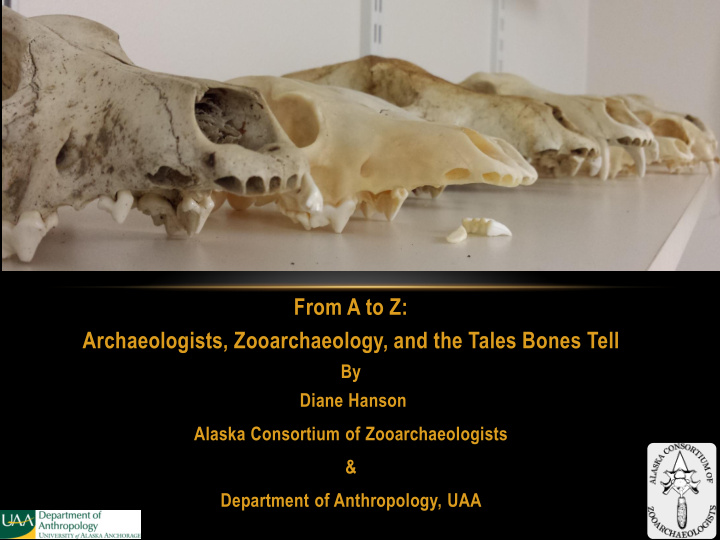



BONE HEAD ARCHAEOLOGY From A to Z: Archaeologists, Zooarchaeology, and the Tales Bones Tell By Diane Hanson Alaska Consortium of Zooarchaeologists & Department of Anthropology, UAA
HOW IS ZOOARCHAEOLOGY DIFFERENT FROM ZOOLOGY?
TIME DEPTH Photograph by Claire Alix
RANGE OF TOPICS ZOOARCHAEOLOGY COVERS taphonomy subsistence Social organization (site formation) ethnicity biogeography Season of occupation environmental religion Butchering diet conditions & site use effects of hunting Climate change on fauna/populations changes in Animal animal morphology domestication
THE COMPARATIVE COLLECTION
Hometown U: Bone collection gives researchers a boost By Kathleen McCoy Hometown U July 6, 2013 Read more here: http://www.adn.com/2013/07/06/2966269/hometown-u-bone- collection-gives.html#storylink=cpy http://www.adn.com/2013/07/06/2966269/hometown-u-bone-collection-gives.html
WHERE DO THE ANIMALS COME FROM? HOW IS THE COLLECTION PREPARED?
A CLEANER, EASIER WAY TO PROCESS
HOW IS A ZOOARCHAEOLOGICAL COMPARATIVE COLLECTION DIFFERENT FROM A ZOOLOGICAL COLLECTION? Synoptic Collection
Taxonomic Collection
WHAT IS STUDIED IN ZOOARCHAEOLGY ? • Bones • Shellfish • Ivory/bone/antler • Scales • Otoliths • Hair • Feathers Specialties
SAMPLING • Screen size affects Presence of smaller animals • • Presence of smaller elements Size of assemblage • • Abundance of taxa
AGING AND SEASON Structures • Growth lines • • Otoliths • Scales • shellfish Antlers • • Tooth eruption Epiphyseal fusion in mammals • • Doesn’t work for birds or fish Oxygen Isotopes • Temperature rises amount of O18 decreases relative to O16 • • Usually used in conjunction with growth line analysis • Presence/Absence of species
TAPHONOMY • Erosion Surface weathering • • Chemical – soil chemistry (acid soils/basic soils) • Water rolling • Water transport Chewing • • Carnivore chewing – usually fresh bone • Rodent gnawing – usually dry bone Ungulate gnawing – for minerals • Butchering • • Cooking Burning • Root etching •
Fishing from Kaiaks, Captains Harbour." 1872. MS 7119 by Henry Wood Elliot http://www.nmnh.si.edu/naa/features/images/7119_13.jpg
THANK YOU
Recommend
More recommend